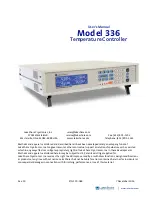
Starting Out
WATLOW Series 1500 User's Manual
5
Starting Out, Chapter 1
control because it will move from one process variable to another in a uniform
manner.
Operator-friendly features include automatic "prompts," or entry codes, to assist you
in programming and monitoring. The Series 1500 has other display codes to indicate
a variety of alarm conditions about your process. The 1500 also has a "Jump Loop"
option for repeating program steps or segments. A "Wait For" option makes this
control responsive to particular process conditions, an external switch conditions or
real times of day.
In addition, you can change the three-mode, PID control to a simple ON/OFF control
by setting the proportional band parameter in each channel to zero.
When there's a power outage, the 1500 has memory protection provided by an
internal Lithium battery and optional battery-backed clock.
The standard RTD version Series 1500 is factory-configured to operate in degrees
Centigrade (
°
C) on Channel One and per cent relative humidity (%RH) on Channel
Two. A software selection, the "Temp-Temp" option, is also available for the RTD
unit. The Series 1500 Thermocouple version is strictly a "Temp-Temp" control. The
1500 has at least two switches you must set prior to entering your program. Informa-
tion on how to set these switches follows in this chapter.
When you first apply power, the unit will "come up" with default values for set points,
alarm points, control parameters, recycle, events and time. These default values
provide minimum operating instructions until you enter your data. The default values
are listed in Chapter 4, "Technical Reference."
Remove the Series 1500 carefully from its shipping container. Be sure to set this
literature aside where it will not be discarded.
Packing List
Included with your Watlow Series 1500 RTD version are two 107
Ω
resistors, four
jumper wires, two mounting brackets with integral screws, and this manual. The
resistors and two jumpers will serve as pseudo-sensors at approximate room condi-
tions while you learn the control. The other jumpers are for power connections.
How to Open the 1500
Before going further, open the Series 1500 and pull the control chassis from its case.
Here's how:
The control chassis fastens to the case with a single screw located at the lower front
panel. Turn the screw counterclockwise to loosen it. Three strip connector plugs, in
the rear of the control chassis, feed power and signals through the back of the case
to the triple terminal strip. These plugs will let go as you pull.
!
Pull firmly but gently to remove the Series 1500 from its case. The 1500 chassis will
not fit into the case upside down. However, always check to see that it is oriented
correctly before returning the chassis to the case. Press the unit in firmly, then turn
the front panel screw clockwise to secure it. Do not overtighten the screw.
!
CAUTION:
Before attempting to
open a Series 1500
with data communi-
cations (RS-422/423
interface), remove
the two screws and
DB-15 male connec-
tor from the rear of
the case.






































